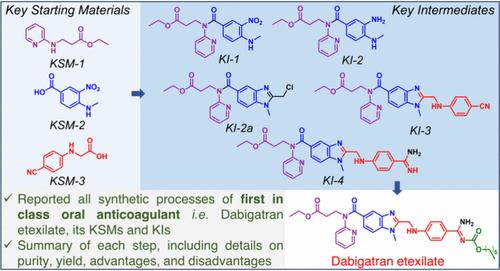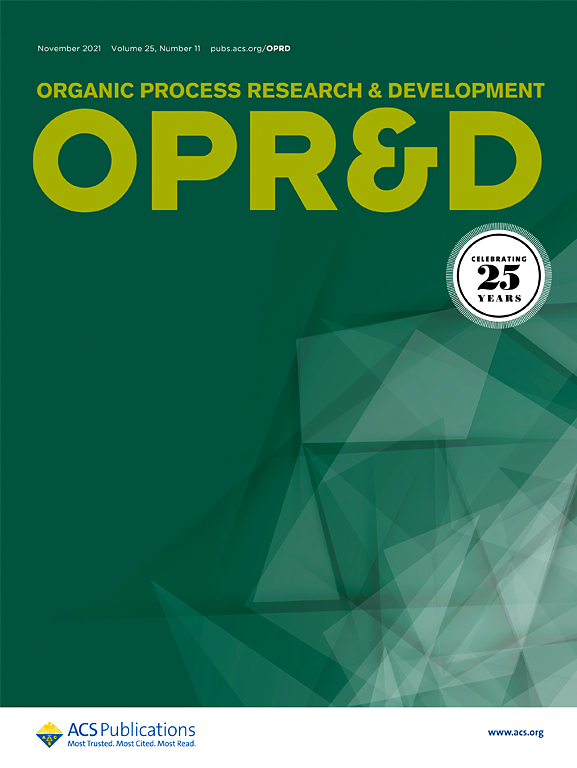口服抗凝药物达比加群酯的合成方法
IF 3.5
3区 化学
Q2 CHEMISTRY, APPLIED
引用次数: 0
摘要
血栓栓塞性疾病影响着全球数百万人。达比加群酯、利伐沙班、阿加曲班、依诺肝素和磺达肝癸等抗凝血药物是治疗大多数此类疾病的常用药物。达比加群酯(PRADAXA)是第一种口服直接凝血酶抑制剂,已成为治疗各种血栓栓塞性疾病的主要抗凝疗法。人们为合成原料药及其中间体做出了大量努力。本综述全面探讨了合成达比加群酯的关键起始原料(KSM)、关键中间体和最终原料药所采用的各种方法。综述还详细介绍了合成过程中产生的各种杂质。为方便读者阅读,本综述分为几个部分,分别介绍了每种关键起始原料和中间体的合成工艺。这篇最新进展综述是从事达比加群酯合成路线开发和优化的研究人员、化学家和制药科学家的宝贵资源。本文章由计算机程序翻译,如有差异,请以英文原文为准。

Synthetic Approaches toward Dabigatran Etexilate, an Oral Anticoagulant Drug
Thromboembolic disorders affect millions of people worldwide. Anticoagulant drugs, such as Dabigatran etexilate, Rivaroxaban, Argatroban, Enoxaparin, and Fondaparinux, are commonly used in treating most of these diseases. Dabigatran etexilate (PRADAXA), the first oral direct thrombin inhibitor of its kind, has become a leading anticoagulant therapy for various thromboembolic disorders. Numerous efforts have been made to synthesize API and its intermediates. This review comprehensively examines the diverse methodologies employed for the synthesis of the Key Starting Materials (KSMs), Key Intermediates, and the final API of Dabigatran etexilate. The review also details the various impurities generated during the process. For the reader’s convenience, the review is organized into sections that separately describe each of the Key Starting Materials and Intermediates’ synthetic processes. This review of recent advancements serves as a valuable resource for researchers, chemists, and pharmaceutical scientists engaged in the development and optimization of synthetic routes to produce Dabigatran etexilate.
求助全文
通过发布文献求助,成功后即可免费获取论文全文。
去求助
来源期刊
CiteScore
6.90
自引率
14.70%
发文量
251
审稿时长
2 months
期刊介绍:
The journal Organic Process Research & Development serves as a communication tool between industrial chemists and chemists working in universities and research institutes. As such, it reports original work from the broad field of industrial process chemistry but also presents academic results that are relevant, or potentially relevant, to industrial applications. Process chemistry is the science that enables the safe, environmentally benign and ultimately economical manufacturing of organic compounds that are required in larger amounts to help address the needs of society. Consequently, the Journal encompasses every aspect of organic chemistry, including all aspects of catalysis, synthetic methodology development and synthetic strategy exploration, but also includes aspects from analytical and solid-state chemistry and chemical engineering, such as work-up tools,process safety, or flow-chemistry. The goal of development and optimization of chemical reactions and processes is their transfer to a larger scale; original work describing such studies and the actual implementation on scale is highly relevant to the journal. However, studies on new developments from either industry, research institutes or academia that have not yet been demonstrated on scale, but where an industrial utility can be expected and where the study has addressed important prerequisites for a scale-up and has given confidence into the reliability and practicality of the chemistry, also serve the mission of OPR&D as a communication tool between the different contributors to the field.

 求助内容:
求助内容: 应助结果提醒方式:
应助结果提醒方式:


